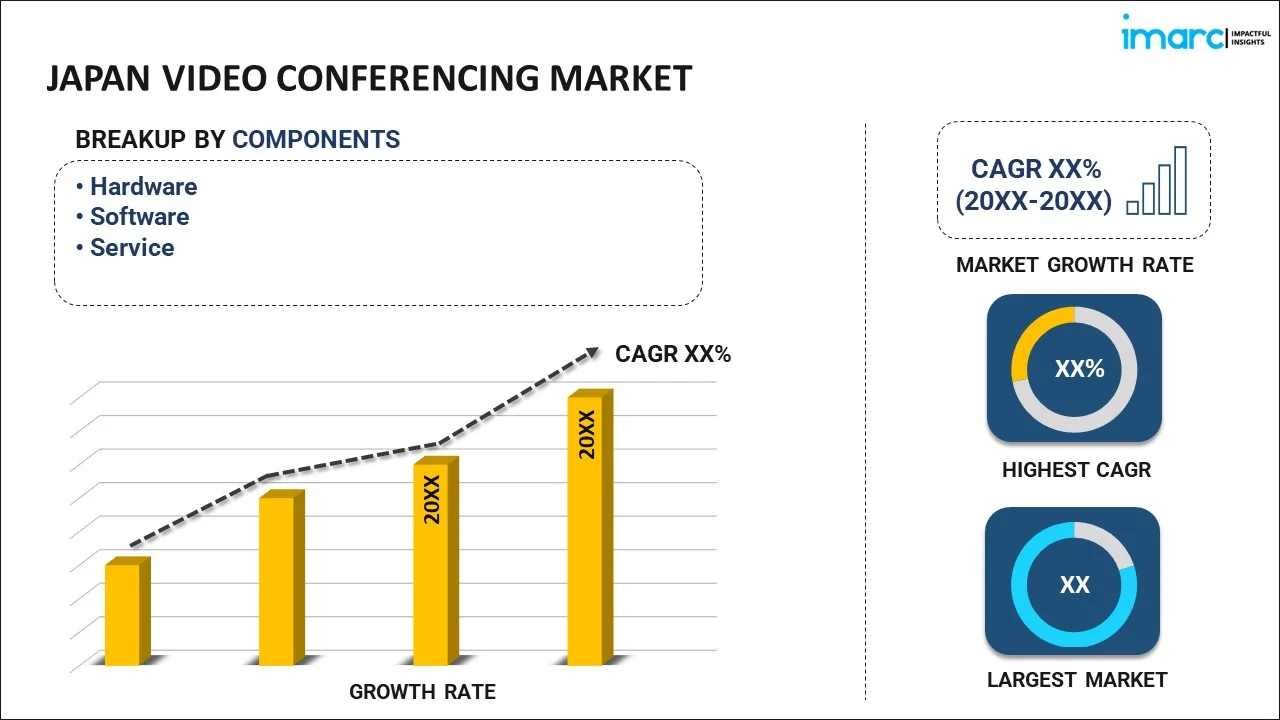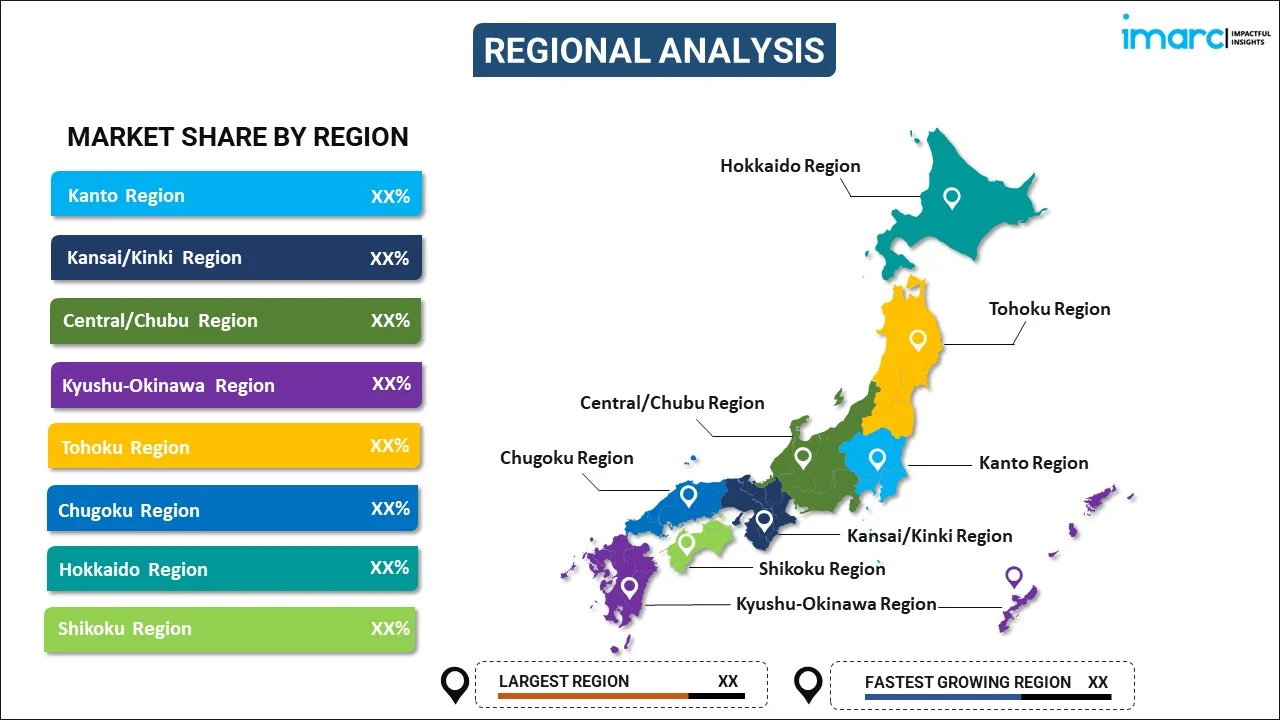
Japan Video Conferencing Market Report by Component (Hardware, Software Service), Conference Type (Telepresence System, Integrated System, Desktop System, Service-Based System), Deployment Mode (On-Premises, Cloud-Based), Enterprise Size (Large Enterprises, Small and Medium-sized Enterprises (SMEs)), Application (Corporate Communications, Training and Development, Marketing and Client Engagement), End Use (Corporate, Education, Healthcare, Government and Defense, BFSI, Media and Entertainment, and Others), and Region 2025-2033
Market Overview:
Japan video conferencing market size reached USD 740 Million in 2024. Looking forward, IMARC Group expects the market to reach USD 1,550 Million by 2033, exhibiting a growth rate (CAGR) of 8.54% during 2025-2033. The growing emphasis on cybersecurity and data privacy, rising trend of remote and hybrid learning environments, and the integration of artificial intelligence (AI) and machine learning (ML) into video conferencing platforms represent some of the key factors driving the market.
|
Report Attribute
|
Key Statistics
|
|---|---|
|
Base Year
|
2024 |
|
Forecast Years
|
2025-2033
|
|
Historical Years
|
2019-2024
|
| Market Size in 2024 | USD 740 Million |
| Market Forecast in 2033 | USD 1,550 Million |
| Market Growth Rate (2025-2033) | 8.54% |
Video conferencing is a technology that allows individuals or groups to conduct face-to-face meetings and discussions from different locations in real-time using video and audio communication over the Internet. It enables seamless visual and auditory interaction, bridging geographical gaps. It provides instant, synchronous communication, enabling participants to interact, which be recorded for future reference. It can be accessed on various devices like computers, smartphones, and tablets, making it versatile and accessible. It offers chat features and the ability to exchange files during meetings. It reduces the need for travel, accommodation, and related expenses, saving time and money. It facilitates efficient communication, reducing the time spent in transit and allowing for quicker decision-making. It enables organizations to collaborate with partners, clients, or employees worldwide without geographical limitations. It eliminates carbon emissions associated with commuting and travel, contributing to sustainability efforts. It is widely used for internal team meetings, client consultations, and partner collaborations. It allows healthcare professionals to diagnose and treat patients remotely. Besides this, it is also employed in the corporate sector to conduct job interviews with candidates from diverse locations. Moreover, as it aids in promoting business continuity during unforeseen circumstances, the demand for video conferencing is increasing across Japan.
Japan Video Conferencing Market Trends:
The rising emphasis on cybersecurity and data privacy is encouraging Japanese organizations to invest in video conferencing solutions that offer robust security features to protect sensitive information. Additionally, the increasing use of video conferencing tools in the education sector of the country is offering a favorable market outlook. The growing trend of remote and hybrid learning environments is catalyzing the demand for secure and reliable video conferencing tools for online classes and virtual lectures. Furthermore, the rising adoption of hybrid and remote work modules is strengthening the growth of the market. Businesses are investing in reliable and feature-rich solutions to facilitate seamless collaboration among geographically dispersed teams. Moreover, governing authorities of the country are undertaking several initiatives to promote digitalization and technology adoption in both public and private sectors, which is propelling the market growth. These efforts include subsidies and incentives for businesses to invest in advanced communication technologies to strengthen their communication. Along with this, the integration of artificial intelligence (AI) and machine learning (ML) into video conferencing platforms is facilitating the market growth. Japanese companies are leveraging AI-driven features like real-time language translation, transcription, and facial recognition to enhance the user experience and break down language barriers in international meetings, making video conferencing more inclusive and accessible.
Japan Video Conferencing Market Segmentation:
IMARC Group provides an analysis of the key trends in each segment of the market, along with forecasts at the country level for 2025-2033. Our report has categorized the market based on component, conference type, deployment mode, enterprise size, application, and end use.
Component Insights:

- Hardware
- Camera
- Microphone/Headphone
- Others
- Software
- Service
- Professional Services
- Managed Services
The report has provided a detailed breakup and analysis of the market based on the component. This includes hardware (camera, microphone/headphone, and others), software, and service (professional services and managed services).
Conference Type Insights:
- Telepresence System
- Integrated System
- Desktop System
- Service-Based System
A detailed breakup and analysis of the market based on the conference type have also been provided in the report. This includes telepresence system, integrated system, desktop system, and service-based system.
Deployment Mode Insights:
- On-Premises
- Cloud-Based
The report has provided a detailed breakup and analysis of the market based on the deployment mode. This includes on-premises and cloud-based.
Enterprise Size Insights:
- Large Enterprises
- Small and Medium-sized Enterprises (SMEs)
A detailed breakup and analysis of the market based on the enterprise size have also been provided in the report. This includes large enterprises and small and medium-sized enterprises (SMEs).
Application Insights:
- Corporate Communications
- Training and Development
- Marketing and Client Engagement
The report has provided a detailed breakup and analysis of the market based on the application. This includes corporate communications, training and development, and marketing and client engagement.
End Use Insights:
- Corporate
- Education
- Healthcare
- Government and Defense
- BFSI
- Media and Entertainment
- Others
A detailed breakup and analysis of the market based on the end use have also been provided in the report. This includes corporate, education, healthcare, government and defense, BFSI, media and entertainment, and others.
Regional Insights:

- Kanto Region
- Kansai/Kinki Region
- Central/ Chubu Region
- Kyushu-Okinawa Region
- Tohoku Region
- Chugoku Region
- Hokkaido Region
- Shikoku Region
The report has also provided a comprehensive analysis of all the major regional markets, which include Kanto Region, Kansai/Kinki Region, Central/ Chubu Region, Kyushu-Okinawa Region, Tohoku Region, Chugoku Region, Hokkaido Region, and Shikoku Region.
Competitive Landscape:
The market research report has also provided a comprehensive analysis of the competitive landscape. Competitive analysis such as market structure, key player positioning, top winning strategies, competitive dashboard, and company evaluation quadrant has been covered in the report. Also, detailed profiles of all major companies have been provided.
Japan Video Conferencing Market Report Coverage:
| Report Features | Details |
|---|---|
| Base Year of the Analysis | 2024 |
| Historical Period | 2019-2024 |
| Forecast Period | 2025-2033 |
| Units | Million USD |
| Scope of the Report | Exploration of Historical and Forecast Trends, Industry Catalysts and Challenges, Segment-Wise Historical and Predictive Market Assessment:
|
| Components Covered |
|
| Conference Types Covered | Telepresence System, Integrated System, Desktop System, Service-Based System |
| Deployment Modes Covered | On-Premises, Cloud-Based |
| Enterprise Sizes Covered | Large Enterprises, Small and Medium-sized Enterprises (SMEs) |
| Applications Covered | Corporate Communications, Training and Development, Marketing and Client Engagement |
| End Uses Covered | Corporate, Education, Healthcare, Government and Defense, BFSI, Media and Entertainment, Others |
| Regions Covered | Kanto Region, Kansai/Kinki Region, Central/ Chubu Region, Kyushu-Okinawa Region, Tohoku Region, Chugoku Region, Hokkaido Region, Shikoku Region |
| Customization Scope | 10% Free Customization |
| Post-Sale Analyst Support | 10-12 Weeks |
| Delivery Format | PDF and Excel through Email (We can also provide the editable version of the report in PPT/Word format on special request) |
Key Questions Answered in This Report:
- How has the Japan video conferencing market performed so far and how will it perform in the coming years?
- What has been the impact of COVID-19 on the Japan video conferencing market?
- What is the breakup of the Japan video conferencing market on the basis of component?
- What is the breakup of the Japan video conferencing market on the basis of conference type?
- What is the breakup of the Japan video conferencing market on the basis of deployment mode?
- What is the breakup of the Japan video conferencing market on the basis of enterprise size?
- What is the breakup of the Japan video conferencing market on the basis of application?
- What is the breakup of the Japan video conferencing market on the basis of end use?
- What are the various stages in the value chain of the Japan video conferencing market?
- What are the key driving factors and challenges in the Japan video conferencing?
- What is the structure of the Japan video conferencing market and who are the key players?
- What is the degree of competition in the Japan video conferencing market?
Key Benefits for Stakeholders:
- IMARC’s industry report offers a comprehensive quantitative analysis of various market segments, historical and current market trends, market forecasts, and dynamics of the Japan video conferencing market from 2019-2033.
- The research report provides the latest information on the market drivers, challenges, and opportunities in the Japan video conferencing market.
- Porter's five forces analysis assist stakeholders in assessing the impact of new entrants, competitive rivalry, supplier power, buyer power, and the threat of substitution. It helps stakeholders to analyze the level of competition within the Japan video conferencing industry and its attractiveness.
- Competitive landscape allows stakeholders to understand their competitive environment and provides an insight into the current positions of key players in the market.
Need more help?
- Speak to our experienced analysts for insights on the current market scenarios.
- Include additional segments and countries to customize the report as per your requirement.
- Gain an unparalleled competitive advantage in your domain by understanding how to utilize the report and positively impacting your operations and revenue.
- For further assistance, please connect with our analysts.
 Inquire Before Buying
Inquire Before Buying
 Speak to an Analyst
Speak to an Analyst
 Request Brochure
Request Brochure
 Request Customization
Request Customization




.webp)




.webp)












